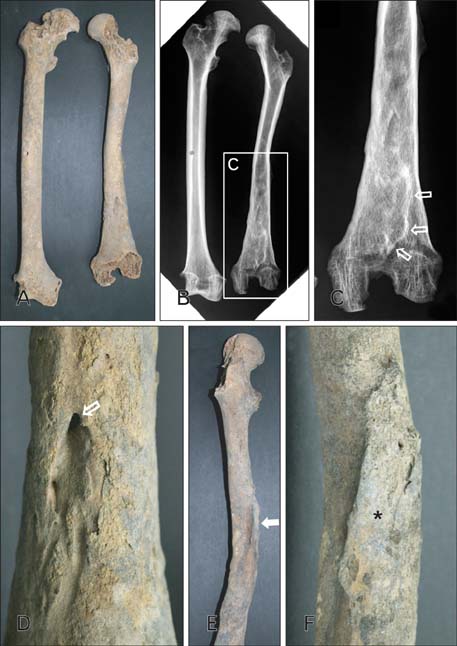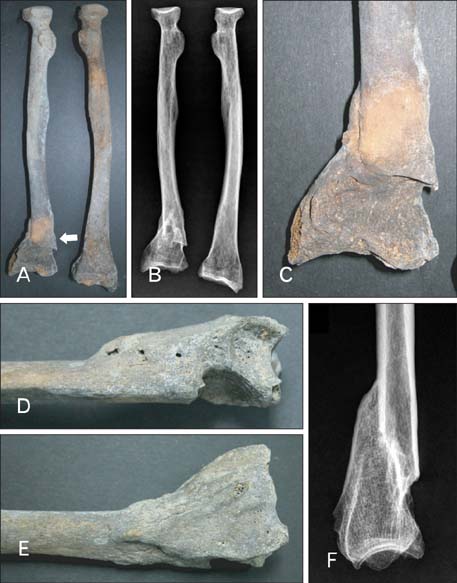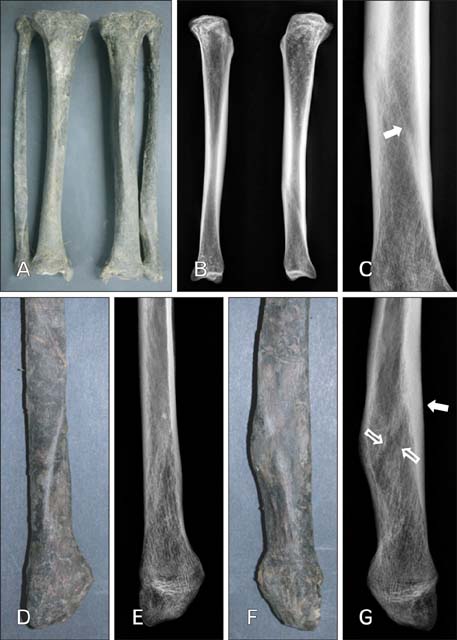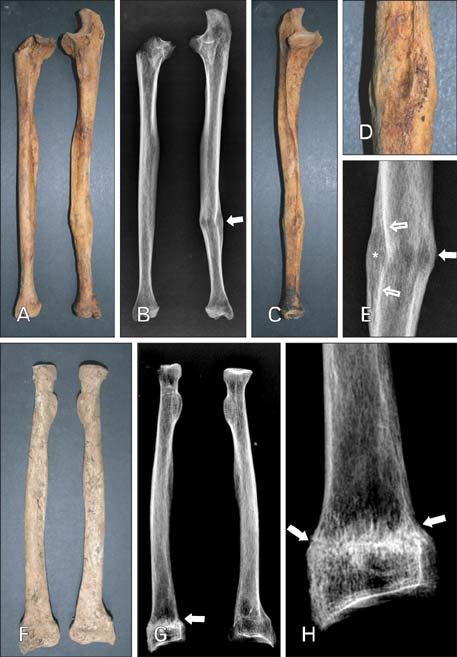Anat Cell Biol.
2013 Sep;46(3):203-209. 10.5115/acb.2013.46.3.203.
Long bone fractures identified in the Joseon Dynasty human skeletons of Korea
- Affiliations
-
- 1Department of Internal Medicine, Seoul National University Boramae Hospital, Seoul National University College of Medicine, Seoul, Korea.
- 2Department of Anatomy, Seoul National University College of Medicine, Seoul, Korea. drdoogi@snu.ac.kr
- 3Department of Anatomy, Dankook University College of Medicine, Cheonan, Korea.
- 4Department of Anatomy, Ewha Womans University School of Medicine, Seoul, Korea.
- 5Institute of Forensic Medicine, Seoul National University College of Medicine, Seoul, Korea.
- 6Division of Forensic Medicine, National Forensic Service, Seoul, Korea.
- 7Institute for the Translation of Korean Classics, Seoul, Korea.
- KMID: 2263147
- DOI: http://doi.org/10.5115/acb.2013.46.3.203
Abstract
- Fracture is one of the pathological signs most frequently encountered in archaeologically obtained bones. To expand the paleopathological knowledge on traumatic injuries, it is desirable to secure data on long bone fractures from as wide a geographic and temporal range as possible. We present, for the first time, evidence of long bone fractures in a 16th-18th century Joseon skeletal series (n=96). In this study, we found 3 Colles' fractures of the radius in 2 individual cases. The pattern of fractures was unique. Although previous reports show that the ulna is broken more often than the radius, ulnar fracture associated with fending off a blunt attack was rare in our series (1/7 cases). Transverse fractures, typically caused by intentional violence, were also very rare (1/7 cases) in this study. These results may reflect the relatively tranquil lives of the Joseon people in 16th-18th century Korea. We also found post-fracture complications such as deformations, bone length shortening, and osteomyelitis. The present study would be of interest to medical scientists in related fields because it is one of the few studies conducted on long bone fractures among pre-modern societies in East Asian countries, thus far.
MeSH Terms
Figure
Cited by 1 articles
-
A modified trans-anconeus approach to facilitate fixation of a posterior radial head fracture: a cadaveric feasibility study
Ahmed Mohamed Desouky, Ahmed Naeem Atiyya, Mohamed Elbishbishi, Marwa Mohamed El Sawy
Anat Cell Biol. 2023;56(1):39-45. doi: 10.5115/acb.22.201.
Reference
-
1. Kilgore L, Jurmain R, Van Gerven D. Palaeoepidemiological patterns of trauma in a medieval Nubian skeletal population. Int J Osteoarchaeol. 1997; 7:103–114.2. Lovell NC. Trauma analysis in paleopathology. Am J Phys Anthropol. 1997; 104:Suppl 25. 139–170.3. Judd MA. Comparison of long bone trauma recording methods. J Archaeol Sci. 2002; 29:1255–1265.4. Ortner D. Identification of pathological conditions in human skeletal remains. 2nd ed. San Diego: Academic Press;2003.5. Lovejoy CO, Heiple KG. Analysis of fractures in skeletal populations with an example form the Libben site, Ottawa County, Ohio. Am J Phys Anthropol. 1981; 55:529–541.6. Larsen CS. Bioarchaelolgy: interpreting behavior form the human skeleton. Cambridge: Cambridge University Press;1997.7. Grauer AL, Roberts CA. Paleoepidemiology, healing, and possible treatment of trauma in the medieval cemetery population of St. Helen-on-the-Walls, York, England. Am J Phys Anthropol. 1996; 100:531–544.8. Yoon HK, Park C, Jang S, Jang S, Lee YK, Ha YC. Incidence and mortality following hip fracture in Korea. J Korean Med Sci. 2011; 26:1087–1092.9. Weidenreich F. The duration of life of fossil man in China and the pathological lesions found in his skeleton. Chin Med J. 1939; 55:34–44.10. Angel JL. Patterns of fractures from neolithic to modern times. Anthropol Kozl. 1974; 18:9–18.11. Hooton EA. The Indians of Pecos pueblo: a study of their skeletal remains. New Haven: Yale University Press;1930.12. Hill P. Whithorn and St. Ninian: the excavation of a monastic town 1984-1991. Stroud: Sutton Publishing;1997. p. 519–562.13. Judd MA, Roberts CA. Fracture patterns at the Medieval Leper Hospital in Chichester. Am J Phys Anthropol. 1998; 105:43–55.14. Judd MA. Trauma and interpersonal violence in ancient Nubia during the Kerma period (ca. 2500-1500 BC). Edmonon, Alberta: University of Alberta;2000.15. Djurić MP, Roberts CA, Rakocević ZB, Djonić DD, Lesić AR. Fractures in late medieval skeletal populations from Serbia. Am J Phys Anthropol. 2006; 130:167–178.16. Kim MJ, Oh CS, Lee IS, Lee BH, Choi JH, Lim DS, Yi YS, Han WJ, Kim YS, Bok GD, Lee SD, Shin DH. Human mummified brain from a medieval tomb with lime-soil mixture barrier of the Joseon Dynasty, Korea. Int J Osteoarchaeol. 2008; 18:614–623.17. Han SS, Baek KW, Shin MH, Kim J, Oh CS, Lee SJ, Shin DH. Dental caries prevalence of medieval Korean people. Arch Oral Biol. 2010; 55:535–540.18. Kim DK, Lee IS, Kim WL, Lee JS, Koh BJ, Kim MJ, Youn MY, Shin MH, Kim YS, Lee SS, Oh CS, Shin DH. Possible rheumatoid arthritis found in the human skeleton collected from the tomb of Joseon Dynasty, Korea, dating back to the 1700s AD. Int J Osteoarchaeol. 2011; 21:136–149.19. Kim YS, Oh CS, Lee SJ, Park JB, Kim MJ, Shin DH. Sex determination of Joseon people skeletons based on anatomical, cultural and molecular biological clues. Ann Anat. 2011; 193:539–543.20. Shin DH, Oh CS, Kim YS, Hwang YI. Ancient-to-modern secular changes in Korean stature. Am J Phys Anthropol. 2012; 147:433–442.21. Lovejoy CO, Meindl RS, Pryzbeck TR, Mensforth RP. Chronological metamorphosis of the auricular surface of the ilium: a new method for the determination of adult skeletal age at death. Am J Phys Anthropol. 1985; 68:15–28.22. Ubelaker DH, Adams BJ. Differentiation of perimortem and postmortem trauma using taphonomic indicators. J Forensic Sci. 1995; 40:509–512.23. Royal Secretariat. The daily records of the Royal Secretariat of Chosun Dynasty (1623-1894). Seoul: National Institute of Korean History;1970.24. Pratt DS, Marvel LH, Darrow D, Stallones L, May JJ, Jenkins P. The dangers of dairy farming: the injury experience of 600 workers followed for two years. Am J Ind Med. 1992; 21:637–650.25. Stueland DT, Lee BC, Nordstrom DL, Layde PM, Wittman LM, Gunderson PD. Case-control study of agricultural injuries to women in central Wisconsin. Women Health. 1997; 25:91–103.26. Shin MH, Yi YS, Bok GD, Lee EJ, Spigelman M, Park JB, Min SR, Shin DH. How did mummification occur in bodies buried in tombs with a lime soil mixture barrier during the Joseon Dynasty in Korea. In : Peña PA, Martin CR, Rodríguez MA, editors. Mummies and Science: World Mummies Research. Santa Cruz de Tenerife: Academia Canaria de la Historia;2008. p. 105–113.27. Kim MJ, Lee IS, Kim YS, Oh CS, Park JB, Shin MH, Shin DH. Diffuse idiopathic skeletal hyperostosis cases found in Joseon Dynasty human sample collection of Korea. Int J Osteoarchaeol. 2012; 22:235–244.28. Judd MA, Roberts CA. Fracture trauma in a medieval British farming village. Am J Phys Anthropol. 1999; 109:229–243.29. Hamilton FH, Boardman J. Fracture tables, with a supplement compiled from Dr. Hamilton's notes by John Boardman comprising in all an analysis of 461 cases of fractures. Buffalo: Jewett, Thomas & Co.;1853.30. Wood-Jones F. Fractured bone and dislocations. In : Eliot-Smith G, Wood-Jones F, editors. The Archaeological Survey of Nubia for 1907-1908. Vol. II. Report on the Human Remains. Cairo: National Printing Department;1910. p. 293–342.31. Mays SA. A palaeopathological study of Colles' fracture. Int J Osteoarchaeol. 2006; 16:415–428.32. Adams JC. Adam's outline of fractures: including joint injuries. Edinburgh: Churchill Livingstone;1983.33. Wesolowski V. Caries prevalence in skeletal series: is it possible to compare? Mem Inst Oswaldo Cruz. 2006; 101:Suppl 2. 139–145.34. Burrell LL, Mass MC, Van Gerven DP. Patterns of long-bone fracture in two Nubian cementeries. Hum Evol. 1986; 1:495–506.
- Full Text Links
- Actions
-
Cited
- CITED
-
- Close
- Share
- Similar articles
-
- The surface and the back of late Joseon medicine - Centered on medical knowledge system -
- Anthropometric Analysis of Buddha's Face of Korea and Joseon Dynasty in Buddhist Paintings and Comparison with the Beauty's Face of Joseon Dynasty
- Stable isotope analysis of Joseon people skeletons from the cemeteries of Old Seoul City, the capital of Joseon Dynasty
- Forensic Anthropological Study on Saw Marks Appearing on the Tibiae of a Joseon Skeleton
- Animal Bones Found at Gongpyeong-dong Archaeological Site, the Capital Area of Joseon Dynasty Period





